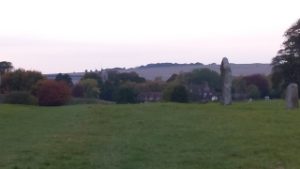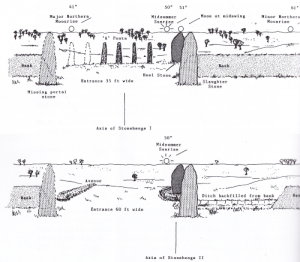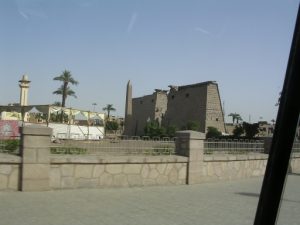
Today is another look at prehistoric monuments in England, and in particular the way sites were reused and reinterpreted by later generations. My main focus is going to be religious or sacred use – obviously some houses and forts stay in use for many hundreds of years, but this doesn’t usually involve much change of purpose.
The modern stereotype is that later religious groups are implacably hostile towards earlier ones, violently trying to erase all signs that things were ever different. Certainly this happens from time to time – the attempted destruction of Palmyra is a glaring recent example – but actually, quiet assimilation of a site is very common.
Let’s look first at Stonehenge. Before the raising of the giant stones which are most people’s association with the site, there was a true henge there. The earliest part of the whole structure is a circular bank with an entrance facing compass point. There was also a ring of wooden posts, including a series set at intervals across the entrance, and a few outlying marker stones picking out specific angles from the centre.

Now, like most henges of its era, it was built around lunar alignments. The centre of the entrance, the postholes across it, items buried at particular places in the ring – even the main outlying stone called the Heel Stone – all of these pick out significant events in the lunar cycle. Now, since a full cycle takes 18.6 years, and it would take a few such cycles to be sure of the observations given inconveniences such as clouds, this already represents a huge summary of embodied knowledge. But let’s move on.
Time passed, as did the original builders, and the site was reused by new people with new beliefs. They didn’t just put up new stuff – like the stones – they repurposed the whole place. The entrance was widened, but asymmetrically, so that the midpoint was now angled to accommodate a solar orientation. You have to wonder if the newcomers were aware of the previous lunar settings and making deliberate changes, or if they just thought the earlier inhabitants had built it wrong. Even in very recent years, we’ve certainly not understood the builders’ purpose.

Whatever the level of knowledge and the motives of the new users, the end result was to rebrand Stonehenge as a solar monument. The great majority of visitors since then have seen only this more recent, more obvious configuration, and the rediscovery of the older focus on the moon has been slow to emerge.
We know nothing about the transition from lunar to solar beliefs. Was it a peaceful and gradual shift, or a sudden and more violent one? Did the circle remain in regular use throughout, or was it abandoned for a while? It seems to me that the fact that the same site was reused, whether after a gap or not, must say something. It would be all too easy for the new solar-oriented worshippers to simply ignore the very obvious bank of earth and wooden posts, and erect their own monument nearby. Yet they chose to carry on in the same place.
Such reuse of an older sacred place by later generations is very common. Many springs and pools held sacred to the traditional religions of the British Isles were adopted by the Romans, Saxons and Normans, often ending up linked with Christian saints and having churches built there. Knowlton church, in Dorset, was situated within the ring of a much older henge, and most of Avebury village is inside the huge extent of the monuments there. In Karnak, part of the Pharaonic temple was used as a Christian church, and subsequently a mosque.

What motivates this reuse? Does it represent a kind of spiritual conquest, in which the new element needs to purify the old? Or is it a way to legitimise the new by means of linking it with a place long held to be sacred? Is it simply that people are already used to going there, and this is a way to set up your pitch where there are already crowds of worshippers? Or is it that some places on earth really do have a heavier weight of sacredness than others, and some sensitivity to this motivates the builders of places of worship?
For the monuments I am thinking of, we will never have historical records which might explain the motives. All we have are enigmatic questions, and the clear signs that religious sites changed their focus over the generations as the original purpose became less important.
Looking forward in time, I wonder what might happen if we encounter signs that alien races have built sacred monuments elsewhere in our solar system or further afield? Will we set up our own shrines among the stones and stellar alignments, and in doing so continue our millennia-old habit of reuse? Right now we have no clear signs of extraterrestrial life of any kind at all, still less life that is sophisticated enough to reflect on the universe and build artefacts in holy places. One day, perhaps.


What do you think about more contemporary re-uses of Stonehenge – as a rock festival venue in the 1970s and nowadays as a sacred site for druids, as a tourist attraction ? As a tourist, I feel English Heritage may be trying to purify the old by packaging it in a way which encourages 21st century visitors to engage with the academic, archaeological aspect of its significance. Contemporary druids (King Uther Pendragon) and the hippies of the 19702 want(ed) to engage with the site more subjectively, and who is to say that they are wrong?
Indeed yes – in all kinds of ways we now try to freeze a site at some particular point in the past rather than letting it change. At a guess, the site has been used for both music and worship since Neolithic times, as well as observations of sun and moon.